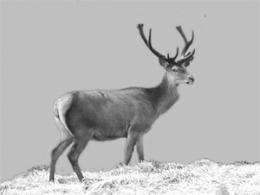DNA analysis uncovers the prehistory of Norwegian red deer

For his doctoral thesis, Hallvard Haanes discovered that Norwegian red deer are genetically different from other European red deer, due to their historical distribution. However, a century ago, red deer were imported from continental Europe to the island of Otterøya in Namsos, and these imported deer have created hybrid forms with the Norwegian red deer on the island. These hybrids have only to a modest degree become integrated with the rest of the Norwegian red deer population.
Red deer colonised Norway after the last ice age. Since then the population has been isolated from the rest of Europe, and on several occasions their numbers were reduced so dramatically that the genetic makeup became altered and genetic diversity was lost.
Analyses of the deer DNA revealed that isolation and population reduction during the eighteenth and nineteenth centuries significantly altered genetic makeup at a time when red deer were limited to just a few locations in western Norway. Genetic code was probably also lost during earlier population collapses, for example, during colonisation. "The animals that survived may be considered to have been well adapted to the Norwegian climate, but such genetic loss may in the long term reduce the ability of red deer to adapt to changes in climate and habitat", says Haanes.
In 1902 and 1904, red deer from Germany and Hungary were introduced to Otterøya, near Namsos. The doctorate shows that the genetic composition of the present-day red deer of Otterøya is a combination of Norwegian and imported forms, but that no negative consequences of this have been seen that might indicate reduced adaptability among the hybrids. Until now, hunting pressure on the hybrids has been so great that foreign genetic material has only to a limited degree been spread to the Norwegian deer population, although the hybrid population is today increasing.
The Norwegian red deer population has increased dramatically during the last century, both in number and distribution. Haanæs showed in his thesis that this increase came about at five or six locations in western Norway, which during the eighteenth and nineteenth centuries were separate entities. The current population consists of five genetically different sub-populations that have spread out from these original groups. The pattern of spread shows a relatively high degree of mixing further east as the deer followed the valleys eastward, while in the west, steep fjords and high mountain ranges created barriers for spread.
Hallvard Haanes has in addition shown that hinds are relatively sedentary and move over shorter distances than do bucks, which wander among the sub-populations to a greater degree. During the expansion of the last century, the hinds most likely moved in family units and therefore maintained the genetic integrity of the five original groups, spread over old and new regions.
The work was carried out under the auspices of the Section of Genetics, the Norwegian School of Veterinary Science, in collaboration with the Department of Health & Social Work Studies, Telemark University College, Norway. In addition, Norwegian and international hunters and veterinarians contributed samples to the project.
Cand. scient. Hallvard Haanes defended his doctoral thesis, entitled "Genetic variation and structure in Norwegian red deer", at the Norwegian School of Veterinary Science, on January 15, 2009.
Provided by Norwegian School of Veterinary Science















